Conan Re-Read: “The Black Stranger”
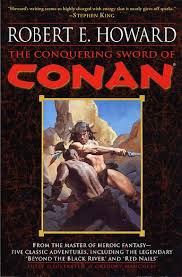 Bill Ward and I are reading through the Del Rey Robert E. Howard collection The Conquering Sword of Conan. This week we’re discussing “The Black Stranger.” We hope you’ll join in!
Bill Ward and I are reading through the Del Rey Robert E. Howard collection The Conquering Sword of Conan. This week we’re discussing “The Black Stranger.” We hope you’ll join in!
Bill: Like “Beyond the Black River” which precedes it, “The Black Stranger” is a tale set in the Pictish wilderness of Hyboria that sees a vulnerable outpost of civilization overrun by the wild men of the wood. But this time around the threat of the Picts — still an Amerindian analog — serve as more of a backdrop to the infighting and machinations of pirate captains, an exiled nobleman, and a cagey Conan. Again REH draws on the American frontier for inspiration, but it isn’t the dominant theme of the piece, which also manages to end on a far more up tempo note despite the carnage. Wild battles, double-crossing, pirate treasure, and a mysterious demonic stranger are all skillfully woven together into a complex but nonetheless fast-paced adventure that stands solidly alongside the better Conan stories.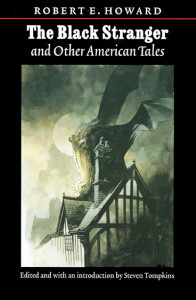
Howard: This one has been the most pleasant surprise out of the whole bunch. I had mis-remembered it as being a kind of unsuccessful mash-up of various elements, but I think now my bad impression probably had to do with my only previous reading of the story being with the version de Camp altered. I was expecting a bit of a slog, and it was a delight to find myself hooked by the opening section. Well, I thought, maybe it’s one of those that starts strong but then loses direction, like “The Vale of Lost Women.” No, it turns out that it just keeps going, with few if any mis-steps.
Bill: Weirdly enough, “The Black Stranger” is thought to have been rejected by Wright, and it was partially rewritten into a Black Vulmea story, which is certainly a more appropriate character and setting for the primary influences of the story. But the story itself, apart from what I feel is a slight pacing issue in the introduction of the two pirate captains in the early chapters of the piece, is a great deal of fun, and features Conan out-fighting, out-thinking, and out-shining every rogue, savage, and hellspawn that crosses his path. I think I’ll just have to finally concede defeat in trying to understand the tastes of the man who rejected this gem of a story (if that is indeed what happened) but raved about “A Witch Shall Be Born.”
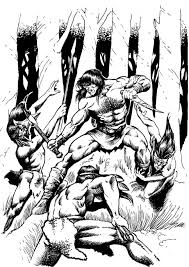 Howard: That’s mind boggling. If THIS was my most pleasant surprise so far during the re-read, “A Witch Shall be Born” was most my UNpleasant. Apart from the two scenes we discussed, that one feels more like a story outline, and Wright thought it was excellent. Yet he rejected this (probably), which starts with a bang and then just keeps going, with plenty of surprises and mystery and great action sequences. The opening chapter is among the best in the entire run of stories. You know, I’ve got the Black Vulmea version around here somewhere. I’ll have to read it and see what the differences are.
Howard: That’s mind boggling. If THIS was my most pleasant surprise so far during the re-read, “A Witch Shall be Born” was most my UNpleasant. Apart from the two scenes we discussed, that one feels more like a story outline, and Wright thought it was excellent. Yet he rejected this (probably), which starts with a bang and then just keeps going, with plenty of surprises and mystery and great action sequences. The opening chapter is among the best in the entire run of stories. You know, I’ve got the Black Vulmea version around here somewhere. I’ll have to read it and see what the differences are.
Bill: I understand the Black Vulmea version is shorter and tighter — perhaps REH dispensed with the Black Stranger subplot entirely? I think that could be done without sacrificing the really interesting parts of the story, which are the competing factions vying for lost treasure and a ship to carry it. While the titular character adds an air of creepy mystery and dread to the proceedings — and, of course, deliberately provokes the attack of the Picts on Valenso’s fort — I found the culmination of that plotline mildly disappointing. If Valenso’s madness had caused further chaos to the defenders or compromised the fort in some way it might have felt as well-integrated as every other aspect of the story, but this is an extremely minor criticism of a tale that, as you say, came as a very pleasant surprise to me as well.
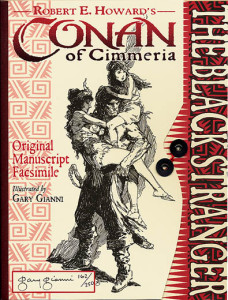 Howard: You’re right — the culmination of the Black Stranger storyline could have been kicked up a notch. I really did appreciate the slow reveal of it, though. That was handled masterfully. And before we get too much further I wanted to chime in and say I didn’t actually have a problem with the pace when Zarono showed up. Right when all hope seemed lost, here comes another pirate, and another problem. As well as an explanation of the cause of the previous problem. REH was really good about introducing multiple competing factions that have to work together without trusting one another.
Howard: You’re right — the culmination of the Black Stranger storyline could have been kicked up a notch. I really did appreciate the slow reveal of it, though. That was handled masterfully. And before we get too much further I wanted to chime in and say I didn’t actually have a problem with the pace when Zarono showed up. Right when all hope seemed lost, here comes another pirate, and another problem. As well as an explanation of the cause of the previous problem. REH was really good about introducing multiple competing factions that have to work together without trusting one another.
Bill: Another appealing aspect of the story is that it shows Conan’s sense of honor. Here again, with REH in frontier mode, it’s framed partially in racial terms as it was in “The Vale of Lost Women.” When you understand that the Picts here represent Native Americans, and that REH’s reading on the topic of the Picts in European history centered on now discredited theories of Picts as non-European, it makes more sense. To a modern reader it still gives pause — the historical Picts were, after all, a Celtic people more akin to Conan’s Cimmerians than to the Zingaran and Barachan “Mediterranean” people he decides to rescue. Of course, in Hyboria things are as REH presents them to be, and the real take away is that Conan, thoroughly barbarian, is yet both an honorable man at his core, and someone that draws a line at certain brands of savagery.
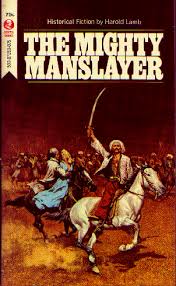 Howard: I do think that’s the way to look at it. And then we have to remember his line from the story when he comments that Cimmerians and Picts have an age old hatred.
Howard: I do think that’s the way to look at it. And then we have to remember his line from the story when he comments that Cimmerians and Picts have an age old hatred.
Bill: That’s very true, too — barbarians are also good at holding grudges. As always, however, it is civilized men who are the worst villains, aiming to betray one another with no qualms, making vows they never intend to keep, and falling upon one another as soon as their mutual suspicions seemed confirmed. Valenso, driven mad with a fear that his own dishonorable greed gave birth to, whips a child and intends to sell his niece as a bride to a vile pirate captain. Conan’s own intended betrayal of the captains — via a method possibly inspired by Harold Lamb’s “The Mighty Manslayer” — at least sticks to the letter of his agreement. It’s once he fails to kill Strom and Zarono and they and their men face torture at the hands of the Picts that Conan shows his sense of fair play — the Cimmerian might slay these men and take their ship and crew with a clear conscience, but he won’t leave them to the horrors of a people that he himself has just recently escaped. And, of course, Conan rescues Belesa and Tina from the clutches of a demonic entity at the end of the story, and gives them a bag of treasure, when he could have simply slipped away as the fort was overrun.
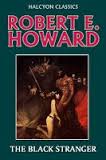 Howard: Several times Belesa’s youth is mentioned and I couldn’t help wondering if Conan’s more protective instincts towards her were called forth because she was just a little too young for him to think it appropriate to consider as a sexual partner, or if he thought that she was too soft and civilized. He’s capable of quite coarse and lusty behavior towards women, as we’ve seen in other tales, and yet here he seems not even to be tempted.
Howard: Several times Belesa’s youth is mentioned and I couldn’t help wondering if Conan’s more protective instincts towards her were called forth because she was just a little too young for him to think it appropriate to consider as a sexual partner, or if he thought that she was too soft and civilized. He’s capable of quite coarse and lusty behavior towards women, as we’ve seen in other tales, and yet here he seems not even to be tempted.
It’s interesting that you mention “The Mighty Manslayer” because there’s a choking gas that has very much the same effect upon protagonists in the tomb of Genghis Khan. As far as I’ve been able to determine — after digging through Howard’s letters and consulting with some REH scholars — it’s unclear that REH read earlier Lamb Cossacks stories; he seems to have discovered Harold Lamb during the second cycle of his Cossack heroes. That doesn’t mean he might not have found some way to read earlier tales. But a strange, choking gas in a treasure trove could have some other inspirational source.
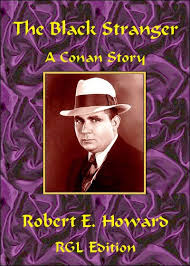 Bill: Having just re-read “The Mighty Manslayer” about a month ago, it was the first thing that leapt to mind. Of course, no reason this idea couldn’t be arrived at independently, or from other fiction I’m not even aware of, and in “The Black Stranger” it obviously doesn’t work out for Conan as it does for Khlit.
Bill: Having just re-read “The Mighty Manslayer” about a month ago, it was the first thing that leapt to mind. Of course, no reason this idea couldn’t be arrived at independently, or from other fiction I’m not even aware of, and in “The Black Stranger” it obviously doesn’t work out for Conan as it does for Khlit.
As for Belesa, I’m not sure if it’s specifically her youth so much as her vulnerability and, quite possibly, her role as a mother to Tina. There is a nice purity at the heart of what Conan did for them both, all without any hope of reward. I know REH often complained about the need to somewhat arbitrarily sex-up his stories, and keeping this relationship innocent was a nice way to further contrast Conan with the leering Zarono and callous Valenso. In my opinion it was certainly the right call on REH’s part in terms of audience expectation, so much so that I didn’t even think about it until you mentioned it.
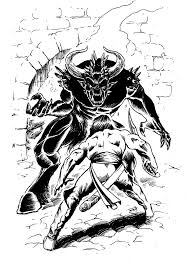 Overall I’d say “The Black Stranger” is the best of the frontier-inspired stories to date, possibly because I had a lot more fun reading it than I did the excellent but rather depressing “Beyond the Black River.” As we touched on last time, that REH wrote both kinds of stories, and a lot more besides, even within the milieu of one serial character, just shows what a tremendous talent he was, and how dedicated he was to his craft.
Overall I’d say “The Black Stranger” is the best of the frontier-inspired stories to date, possibly because I had a lot more fun reading it than I did the excellent but rather depressing “Beyond the Black River.” As we touched on last time, that REH wrote both kinds of stories, and a lot more besides, even within the milieu of one serial character, just shows what a tremendous talent he was, and how dedicated he was to his craft.
We’ve only got two stories left, one I remember liking a great deal and one, next week’s “Man-Eaters of Zamboula,” that I’m afraid to say I don’t remember at all.
Howard: I remember “Man-Eaters” being a bit of a dud, but I hope I’m wrong. I, too, enjoyed this one more than “Beyond the Black River” and I wonder if part of the appeal has something to do with several ongoing mysteries. Who, or what, is the Black Stranger? For several chapters after Conan’s initial appearance we can’t help wondering what’s happened to him, because his fate was left uncertain. Later we see that Belesa has no good choices and wonder how it will all work out with her… and how Conan will out think Strom and Zarono is a head scratcher. “Beyond the Black River” is arguably a more powerful, more deeply resonant work, but it doesn’t have the mystery to drive me forward and that’s another reason I liked reading this one better, even though it’s a little more on the purple end of the spectrum.
In any case, we’ll see you next week for the penultimate Conan adventure completed by Robert E. Howard.
16 Comments